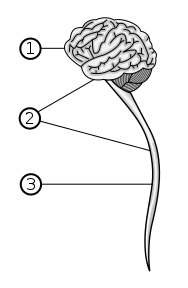<Click to enlarge>
About Me

- Alwin Sambul
- I am a lecturer and also IT engineer. But currently I am studying Medical Bioengineering in Kumamoto University, Japan. My research focuses on Facial Perception.
Monday, May 31, 2010
Sunday, May 30, 2010
Split Brain Theory
In 1981 Roger Sperry was awarded the Nobel Prize for his proof of the split brain theory. According to Dr.Sperry, the brain has two hemispheres with different but overlapping functions. The right and left hemispheres of the brain each specialize in distinct types of thinking processes.
In general, in 95 percent of all right-handed people, the left side of the brain not only cross controls of the right side of the body, but is also responsible for analytical, linear, verbal and rational thought. (In most left-handed people, the hemispheric functions are reversed.) It is left-brain function you rely on when balancing your checkbook, remembering names and dates, or setting goals and objectives. Since most of our concepts of thinking come from Greek logic, left-brained processes are most rewarded in our education system.
On n the contrary, the right hemisphere controls the left side of the body and is holistic, imaginative, nonverbal, and artistic. Have you felt fall in love? Well, whenever you miss or recall someone’s face, become engrossed in a symphony because of him, or simply daydream, you are engaging in right-brain function. Right-brain processes are less often rewarded in school (at least that's experience which I have experience of.)
-- Evi
Source:
http://life-improving.blogspot.com/2007/11/split-brain-theory.html
The Split Brain Experiments
Background

Nobel Laureate Roger Sperry.
In the 19th century, research on people with certain brain injuries, made it possible to suspect that the "language center" in the brain was commonly situated in the left hemisphere. One had observed that people with lesions in two specific areas on the left hemisphere lost their ability to talk, for example.
The final evidence for this, however, came from the famous studies carried out in the 1960s by Roger Sperry and his colleagues. The results of these studies later led to Roger Sperry being awarded the Nobel Prize in Physiology or Medicine in 1981. Sperry received the prize for his discoveries concerning the functional specialization of the cerebral hemispheres. With the help of so called "split brain" patients, he carried out experiments (just like the one you can perform by yourself in the Split Brain Experiments Game), and for the first time in history, knowledge about the left and right hemispheres was revealed.
What Does "Split Brain" Mean?

In the 1960s, there was no other cure for people who suffered from a special kind of epilepsy than by cutting off the connection, corpus callosum, between the two hemispheres. Epilepsy is a kind of storm in the brain, which is caused by the excessive signaling of nerve cells, and in these patients, the brain storm was prevented from spreading to the other hemisphere when the corpus callosum was cut off. This made it possible for the patients to live a normal life after the operation, and it was only when carrying out these experiments one could notice their somewhat "odd behavior."
Each hemisphere is still able to learn after the split brain operation but one hemisphere has no idea about what the other hemisphere has experienced or learned. Today, new methods and technology in split brain operation make it possible
to cut off only a tiny portion and not the whole of the corpus callosum of patients.
What Came Out of the Split Brain Experiments?

Right vision field is connected to the left hemisphere. Left vision field is connected to the right hemisphere.
The studies demonstrated that the left and right hemispheres are specialized in different tasks. The left side of the brain is normally specialized in taking care of the analytical and verbal tasks. The left side speaks much better than the right side, while the right half takes care of the space perception tasks and music, for example. The right hemisphere is involved when you are making a map or giving directions on how to get to your home from the bus station. The right hemisphere can only produce rudimentary words and phrases, but contributes emotional context to language. Without the help from the right hemisphere, you would be able to read the word "pig" for instance, but you wouldn't be able to imagine what it is.
"The great pleasure and feeling in my right brain is more than my left brain can find the words to tell you."
Roger Sperry
Source:
http://nobelprize.org/educational_games/medicine/split-brain/background.html
Otak pada Vertebrata
Otak pada semua mahluk bertulang belakang (vertebrata) berkembang dari tiga bagian utama (lihat gambar):
- Forebrain (pink)
- Midbrain (gray)
- Hindbrain (red)

Gambar di atas, memberikan perbandingan berbagai perkembangan otak vertebrata (katak, reptil, burung dan manusia) dari ketiga bagian tersebut.
Source:
http://users.rcn.com/jkimball.ma.ultranet/BiologyPages/C/CNS.html
Sistem Syaraf Manusia
CNS (Central Nervous System) terdiri atas:
- Spinal cord
- Otak
Spinal Cord
- Menghantarkan informasi sensorik dari PNS (Peripheral Nervous System) ke otak
- Menghantarkan informasi motorik dari otak ke berbagai effector.
- Skeletal muscles
- Cardiac muscles
- Smooth muscles
- Glands
- Bertindak sebagai pusat tanggap minor (minor reflex center)
Otak
- Menerima input sensorik baik dari spinal cord maupun dari sistem syarafnya sendiri (olfactory dan syaraf optik)
- Memberikan sebagian besar dari volumen dan kemampuan komputasinya untuk pemrosesan berbagai input sensorik dan memicu output motorik yang sesuai dan terkoordinasi.
Source:
http://users.rcn.com/jkimball.ma.ultranet/BiologyPages/C/CNS.html
Sistem Syaraf Pusat
Central Nervous System (CNS) adalah bagian dari system syaraf (Nervous System) yang mengatur aktifitas semua bagian tubuh pada binatang bilaterian, yakni semua binatang multiselular kecuali sponge dan binatang simetris radial seperti ubur-ubur. CNS berisi hampir semua sistem syaraf dan terdiri atas otak dan spinal cord, termasuk retina. Bersama dengan system syaraf periferal, CNS memiliki peranan penting untuk mengendalikan perilaku.

Keterangan:
- Otak
- Sistem syaraf pusat
- Spinal cord



